SCHEDULE YOUR INBODY SCAN
The InBody Test provides a comprehensive view of body composition balance.
Body water, proteins, minerals, and body fat, which are the components of the human body closely relate to the status of our health. Using the method of quantitative analysis, these elements of body composition and body composition analysis provide basic information required for assessing the status of the body.
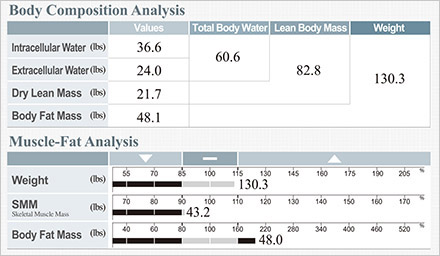
The InBody utilizes the BIA method.
First used in the late 1960s, the bioelectrical impedance analysis (BIA) method measures body water by obtaining the impedance index. The impedance index is obtained by applying a small alternating current on the body, based on the principle that the body contains water and that the level of electric resistivity, i.e., resistance, changes according to the amount of water in the body.
In the late 1980s, the BIA method was a single-frequency whole-body impedance measurement that yielded inaccurate results, and required the use of statistical variables for correction of measurements. However, the Empirical data used in the formula were highly specific and could not be applied universally, and in turn affected overall precision.
The InBody technology overcomes limitations of early BIA.
Motivated through understanding the cause of BIA’s inaccuracy as a limitation in technology, the solution for the limitation could be solved through technological innovation. In 1996, Dr.Cha developed the InBody, “world’s first commercial BIA body composition analyzer, capable of both direct measurement of body segments and multi-frequency measurement”.
Today, the advancement to BIA technology brought out by the InBody with exceptional precision and ease of use is widely recognized by experts worldwide. The InBody is mentioned in hundreds of research papers published every year across various fields such as nutrition, sports, and obesity.
Independent trunk measurement through Direct Segmental Measurement.
Body water, proteins, minerals, and body fat that compose of the human body closely relate to the status of our health. Using the method of quantitative analysis, these elements of body composition and body composition analysis provide basic information required for assessing the status of the health of the body.
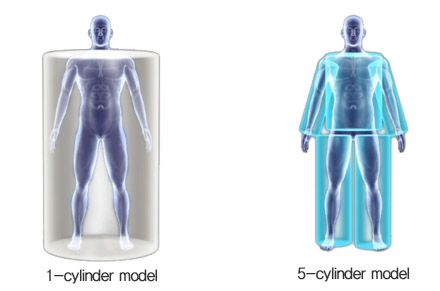
However, the InBody accurately analyzes the total body composition by separately measuring impedance of the body trunk (aka torso), which accounts for as much as 50% of total body weight and has different cross-sectional areas than the arms or legs.
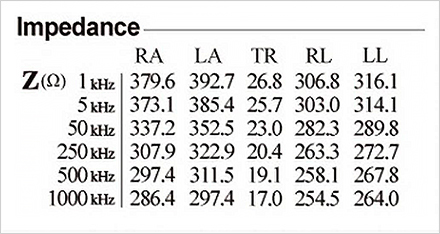
Accuracy through multi-frequency measurement
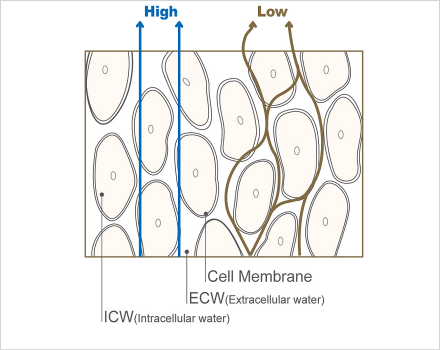
The InBody’s multi-frequency measurement method accurately measures Intracellular water and extracellular body water by using multiple broadband frequencies in the range of 1kHz-1000kHz.
The ability of the current to pass through cell membranes varies according to its frequency. Accuracy of the earlier BIA method were not reliable, as it only used a single frequency at 50kHz to distinguish between intracellular and extracellular body water.
The InBody overcame the limitations of the early BIA, which relied only on a constant proportional formula for deriving total body water. With introduction of water balance category, The InBody is widely used in fields of nephrology and rehabilitation therapy.
8-Point Tactile Electrode with Patent Thumb Electrode for ease of use and precision.
By taking the structural characteristics of the human body into consideration, the InBody uses 2 current and voltage electrodes for each hand and foot, requiring the user to grasp and step on to a total of 8 electrodes.
The design significantly improves ease of use for repeated tests, even when the measuring posture is changed or when measurements are taken multiple times. The measurement always starts and ends at the same points—the wrists and the ankles—ensuring accurate results.
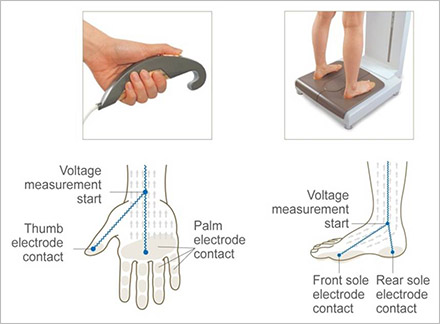
Accounting for special body types without using statistical variables
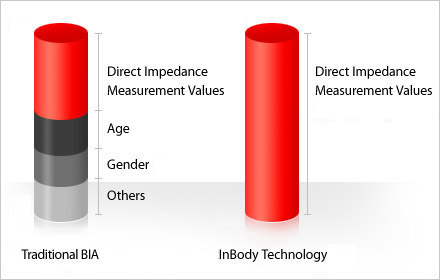
Statistical variables are factors used in a formula for calculating body composition, such as gender, age, or body type.
They were used to compensate for the inaccuracy of the earlier BIA methods. However, since the InBody uses direct impedance measurement, Multi-Frequency measurement, and 8-Point Tactile Electrode with Patent Thumb Electrode, body composition can be derived accurately without having to use any statistical variables.
By detecting sensitive changes in body composition primarily through impedance measurement the InBody has proven an unusually high level of precision, showing a correlation coefficient of 0.98 with DEXA, a gold standard in body measurements. The InBody is widely used clinically and in research where monitoring changes in body composition is important.

